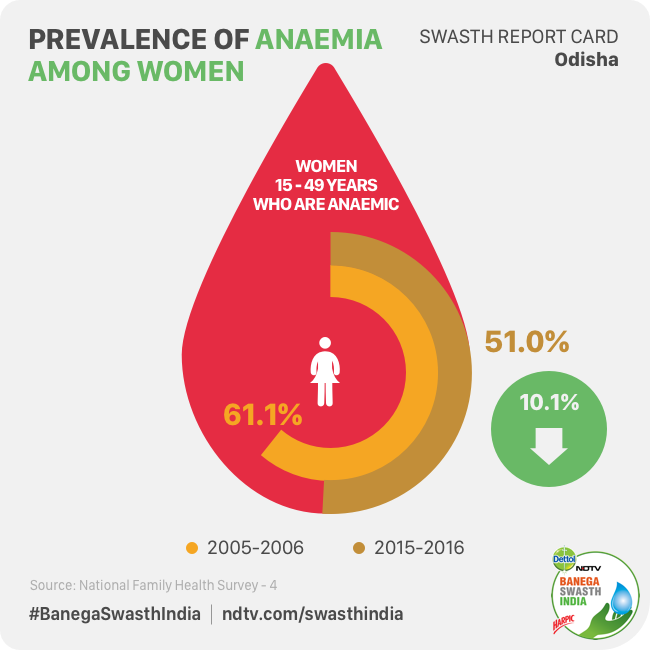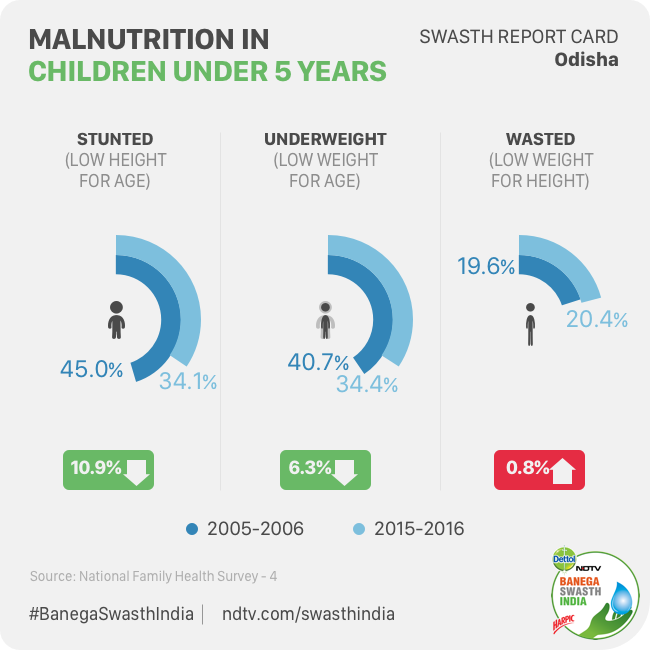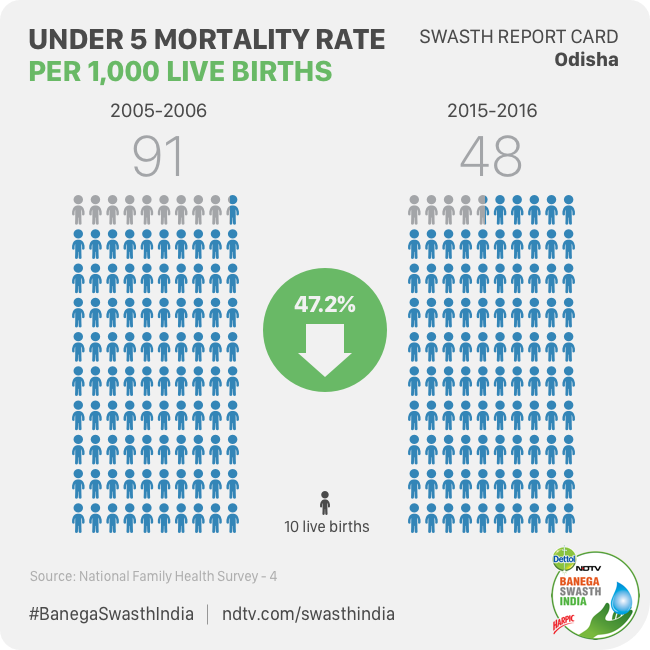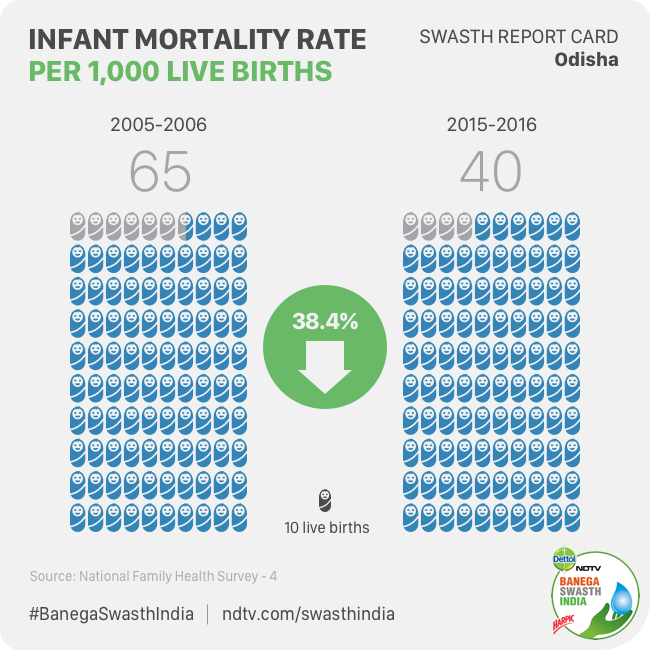New Delhi: In 1984 Kalahandi district of Odisha got famous for famine and starvation deaths, the district made headlines across the country with news of Phanus Punji, a poor woman selling her sister-in-law Banita for Rs 40 and a saree to feed other members of her family. Then Prime Minister Rajiv Gandhi had to fly down to Kalahandi to see for himself the extent of the poverty in which people were struggling to live. The sad and dismal status of the district also made the government pump in funds and initiate special schemes. In 2016, Kalahandi again came in the spotlight with the gut-wrenching tale of Dana Majhi, who carried his wife’s body on his shoulders for 10 km as he had no money to afford a hearse van.
Now in 2019, Odisha is again in the news, only this time for being conferred the title of ‘Nutrition Champion’ of the country by International Food Policy Research Institute (IFPRI), an international agricultural research center, in August. According to the government data studied by IFPRI, Odisha has taken various steps over the years to change the grim reality of being one of India’s famous states for starvation deaths.
Also Read: Swasth Guide: A-Z About Malnutrition And What It Entails
International Food Policy Research Institute Gives Odisha The Title Of ‘Nutrition Champion’: Key Findings Of The Report
According to the IFPRI report on three aspirational districts (according to the government, districts that have shown relatively lesser progress in key social areas and have emerged as pockets of under-development are called as aspirational districts) of Odisha – Jagatsinghpur, Keonjhar and Kalahandi, from 2006 the state’s stunting (low height for age and a sign of malnutrition) has reduced by nearly 11 percent from 45 per cent of children below five years in 2005-06 to 34.1 per cent in 2015-16, slightly above the national average of 10 per cent.
The state also performed better than other poor states like Bihar, Madhya Pradesh, which saw a decrease in stunting cases for 7.3 and 8 per cent respectively.
Over the decades, particularly in the recent past, Odisha has made impressive leaps with respect to improvement in health and nutrition indicators. As per the latest NFHS 4 reports of 2015-16, stunting rates in Odisha are lesser (34.1%) than the national average of 38.4%, which is a significant improvement from what the rates were, as per NFHS-3 reports (45%). There are also improvements in early initiation of breastfeeding and exclusive breastfeeding, and reduction in the percentage of women and children anaemic between NFHS-3 (Women 61.1%, Children 65%) and NFHS 4 (Women 51%, Children 44.6%). Even the latest International Food Policy Research Institute reports suggest that Odisha has shown tremendous improvements in reducing childhood undernutrition as compared to other states in India.
While discussing improvements in health and nutritional indicators, we must also keep in mind that Odisha state has a high number of Particularly Vulnerable Tribal Groups. These groups are concentrated in particular districts. Stunting of children below five years in these districts is higher than the national average (38.4%), for eg. 43.5% in Rayagada, or 45.7% in Malkangiri. In these areas, there are distinct characteristics like difficult geographic terrain, social isolation, specific customs of each indigenous groups, and other challenges with respect to logistics and retention of health staff in healthcare facilities. Thus, with more coordinated efforts of the Government and other community engagement measures in nutrition activities, these districts would be able to accelerate their progress. We need the most recent nutrition data from individual districts so as to look into the progress they have made in the most recent past, says Dr. Pujitha S.Padmanabhan, Indian Institute of Public Health – Bhubaneswar and Public Health Foundation of India.
The IFPRI report also states that apart from reducing cases of stunting, Odisha outperformed in India’s Integrated Child Development Services programme, which is the world’s largest nutrition programme, launched in 1975 to address health, nutrition and pre-school education of children under the age of six. Odisha reached 34% more people in 2017 than it had in 2014, which is better than the richer states, such as Gujarat, and the poor states such as Bihar.
In addition, Antenatal Care (regular check-ups that allow doctors or midwives to treat and prevent potential health problems throughout the course of the pregnancy) in Odisha went up from 48.3% of beneficiaries in 2005 to 64% in 2015, compared to other bigger states like Bihar and Maharashtra. In Bihar, it increased marginally from 16.9% in 2005-06 to 18.7% in 2015-16. In Maharashtra, it increased by 5.5 per cent from 62.1% to 67.6% according to the IFPRI report. The national average of improvement in Antenatal Care in India is 14.7 per cent (from 43.9% in 2005-06 to 58.6% in 2015-16).
The IFPRI report also states that the overall, exposure to nutrition interventions during pregnancy was high in Odisha, with 85 percent of the mothers in the state reporting exposure to counseling on pregnancy care, Iron-Folic Acid Supplementation (IFA), and food supplementation.
A senior official from Collective Action for Nutrition (CAN), an organisation that is working in 24 blocks of Kalahandi Balangir Koraput Region districts in Odisha says,
Over the years Odisha’s nutrition status has changed, but the road to a healthy state is still a long way off. Government interventions through anganwadis centres, mid-day meals and Integrated Child Development Services (ICDS) programme and Mamata, the two big-government schemes on nutrition, to name a few have helped Odisha in becoming a healthy state but government needs to be put out the data of these schemes and its effect in the public domain for greater transparency. Moreover, regular monitoring whether through social audits or frequent training and sensitisation of Jaanch Committee (JC) and Matru Committee (MC) (community monitoring committees crucial to fight malnutrition) members can help improves these numbers and strengthens the ICDS in the state.’
Also Read: Swasth India: Malnutrition Causes 45 Per Cent Child Deaths In India
On The Flip Side: Odisha Tagged As Worst Performing State According To NITI Aayog’s Health Index Report
The government think tank, NITI Aayog’s ‘Healthy States Progressive India’ report, which was released this year shows Odisha has slipped to bottom three of 21 large states in the overall performance on various other health indicators. The performance of the state has been taken into account from 2014-15 (base year) to 2015-16 (reference year). The Niti Aayog report states that the health index score for the state has reduced mostly due to worsening of full immunisation rate and tuberculosis (TB) treatment success rate.
Also Read: One Death Occurs Every 11 Seconds Among Babies And Pregnant Mothers, Says United Nations
Key Findings On Odisha In Health Index Report
As per the NITI Aayog’s Health Index report, from 85.3 per cent coverage in 2015-16 to 59.8 per cent in 2017-18, the State reported more than 25 percentage point decline in the fully-immunised children. Also, TB treatment success rate has slipped from 88.9 per cent in 2015 to 72.5 per cent in 2016.
Moreover, as per the NITI Aayog report, among the larger states, Odisha had the highest Neonatal Mortality Rate (NMR), which refers to death of a live-born baby within the first 28 days of life. In case of Odisha the NMR dropped from 35 to 32 neonatal deaths per 1,000 live births from 2015 to 2016. Similarly, the state had the highest Under 5 Mortality Rate (U5MR) – the probability of dying before completing the age of five – which is a critical indicator of child survival.

Odisha had reported more than 25 percentage point decline in the fully-immunised children, states NITI Aayog’s Health Index Report 2019

Niti Aayog Health Index Report 2019 also reported that Odisha had the highest Neonatal Mortality Rate (NMR)
After seeing NITI Aayog’s Health Index report, newly elected BJP MP Aparajita Sarangi from Bhubaneshwar raised concern in one of the Lok Sabha sessions and said, “It is unfortunate that Odisha in Health Performance Index has slipped to the 19th position and is one of the third worst-performing states. It is an urgent issue and demands immediate concern.”
She also said that the neonatal mortality rate was no better than Sierra Leone, one of the poorest African nations. Ms Sarangi has also requested centre and Ministry of Health and Family welfare to seek a report from Odisha government.
What Odisha’s Authorities Have To Say About Niti Aayog’s Health Index Findings
Commenting on NITI Aayog’s statistics, a senior official from Department of Health and Family Welfare of Odisha, said,
As per the NFHS 4 report, Under 5 Mortality Rate (U5MR) in Odisha has reduced from 91 (2005-06) to 48 (2015-16). We have already raised objections at NITI Aayog’s rankings and have asked them for a revision. Also, the Health Index report shows date from 2014-15 (Base Year) to 2015-16 (Reference Year), it doesn’t show the progress from 2005 which is the basis of NFHS report. Recently, Health Minister Naba Kishore Das also met the UNICEF’s state Chief Monica Nelson to discuss the various schemes being implemented to decrease the mortality rate of mothers and children in the state. Moreover, to reduce infant mortality rate (IMR) as well as mother mortality rate (MMR), Odisha has already launched SAMPURNA — (Sishu Abond Matru Mrityuhara Purna Nirakaran Abhijan) programme under the State budget to increase institutional deliveries. Under the programme, the government has also set a target of reducing Maternity Mortality Rate and Infant Mortality Rate and efforts are being made continuously via different schemes in the state.
Odisha State Government has raised objections over the state’s ranking in Niti Aayog’s ‘Healthy States, Progressive India’ report. Odisha’s Chief Secretary AP Padhi has also written a letter to CEO of Niti Aayog Amitabh Kant to revise the rankings, ‘by basing it on actual data’. A P Padhi in his letter highlighted that the state-administered Measles and Rubella (MR) vaccine from January 29 to April 6 and achieved 98 per cent coverage, but this did not reflect in the ranking as there was no separate category to report MR vaccination. In the letter, AP Padhi wrote, “As MR also contains the measles vaccine; it implies that children below the age of one year have received the vaccine. Full immunisation coverage has always been more than 84 per cent for the last five years. Accordingly, the State’s achievement on full immunisation coverage may be revised.”
Also Read: National Nutrition Month: Importance Of Breastfeeding For Both Mother And Child
On the other hand, citing the National Family Health Survey data, Tukuni Sahu, Minister, Women and Child Development & Minister of State added,
The government of Odisha over the years has been relentlessly working towards improving nutrition status of children below 6, adolescent girls and pregnant and nursing women. Many important initiatives on this front have been taken and we have made a progress in improving state’s nutrition goals. NFHS -4 data reveals that for the first time the state has bettered it’s health and nutrition indicators vis-à-vis national figures, with infant mortality rate of 40 (against national average of 41); child mortality rate at 48 (against national average of 50); severely underweight at 34.4 (against national average of 35.7); stunting at 34.1 (against national average of 38.4) to name a few.
Ms Sahu further explains the Odisha government initiatives taken on the nutrition front and said,
Under our Supplementary Nutrition Programme (SNP) we have revised our menu keeping calorie and protein higher than Government of India recommendations. The state is also one of the few Indian states that provides eggs to combat under-nutrition. The government provides 5 eggs a week for children aged 3-6 years in Anganwadi centres and 3 eggs a week each to pregnant mothers, lactating mothers and children aged 6 months to 3 years.
Along with these steps, the Odisha government, under their Mamata Scheme, which was launched by the state government in September, 2011 with an aim to reduce maternal and infant mortality, recently also extended the benefits to the Particularly Vulnerable Tribal Groups (PVTG) in the state for another five years. This is an important step, as among the 75 listed PVTG’s in the country the highest number – 13 is found in Odisha. As per the Mamta scheme, adult pregnant women, barring government employees, receive Rs 5,000 in two installments that are beneficial for their and their newborn’s health.
According to the Odisha government, they have reached more than 38.89 lakh pregnant and lactating women through Mamata scheme by disbursing more than Rs 1810.76 crore.
Talking about development of Anganwadis in Odisha, Ms Sahu added,
We are working on transforming all state’s Anganwadis centres into vibrant, joyful, child-friendly learning centres. Odisha has already released separate modules for parents and teachers along with books, puzzles, pictorial books that will foster brain development of a child. Most interestingly, books in mother tongues of tribal children have also been published. Soon, we will be able to distribute these books to the Anganwadi centres across the state.
A senior official from Women and Child Development talking about further plans of the state in enhancing Anganwadis centre said,
We will also be making a curriculum and timetable for all our 72,500 anganwadi centres, this will help keep the children engaged. There will be prayers, recitation, play time, storytelling, drawing and other activities, similar to schools and we will also plan to engage parents and other family members.
The Challenge For Odisha To Be Malnutrition-Free Remains
Prime Minister Narendra Modi has set a target to make India malnutrition-free by 2022 and in a bid to achieve this, September is being observed as Rashtriya Poshan Maah or National Nutrition Month to raise awareness about the importance of nutrition. The government also aims and plans to reduce stunting prevalence in children (0-3 years) by about three percentage points per year by 2022 from NFHS-4 levels.
The target of a malnutrition-free India by 2022 looks like an ambitious goal, especially given that the decadal decline in stunting from 48% in 2006 to 38.4% in 2016 is only one percentage point a year, according to the latest NFHS-4 report. The government’s target of the mission – Kuposhan-Mukt Bharat (malnutrition-free India) by 2022 is to bring down the proportion of stunted children in the age-group 0-6 years from 38.4 per cent to 25 per cent of the population by 2022.
As per, NFHS 4, though stunting in Odisha has reduced by nearly 11 per cent from 45.% of children below five years in 2005-06 to 34.1% in 2015-16, the focus should be on to reduce stunting and malnutrition cases in the aspirational districts of the state where the Particularly Vulnerable Tribal Groups are living. To meet the national target, Odisha needs to reduce stunting by close to 3 per cent every year. According to NFHS 4 report, Odisha has made faster progress than other poor states, but not all nutrition indicators showed advances – for example, Children under 5 years who are wasted have increased by 1 per cent since 2005 in the state, whereas, Odisha stays behind in reducing the number of children under 5 years who are underweight, in comparison to other backward states – Madhya Pradesh and Bihar. From 2005 to 2016, the state has seen a 6 per cent decline, whereas, Madhya Pradesh and Bihar has seen a decline of 17.2% and 12% respectively.
NFHS 4 further states that in Odisha almost 8% children are ‘severely affected malnourished’ (SAM) and 30% children fall under Grade I-IV malnutrition. The infant mortality rate (IMR) is at 40 (per 1000) and Under-five mortality rate (U5MR) at 48 (per 1000) in 2015-16, whereas, India’s IMR is at 41 and U5MR is at 50. Odisha government through its schemes like MAMTA and Sampurna is trying to bring down its infant mortality rate (IMR) and the maternal mortality rate (MMR). The government has set a target of reducing the MMR to 117 by 2020 and to 70 by 2030. Whereas, the target to reduce IMR has been set to 30 by 2020 from the current 40. So while the state‘s efforts are in the right direction, the goal of it becoming malnutrition free is still a challenging one.
Note: NFHS-4 fieldwork for Odisha was conducted from 21 January 2016 to 4 July 2016 and information was gathered from 30,242 households, 33,721 women, and 4,209 men

































